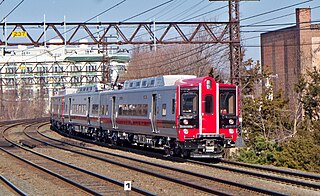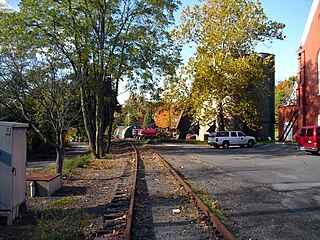
Metro-North Railroad, trading as MTA Metro-North Railroad, is a suburban commuter rail service run by the Metropolitan Transportation Authority (MTA), a public authority of the U.S. state of New York and under contract with the Connecticut Department of Transportation. Metro-North serves the New York Metropolitan Area, running service between New York City and its northern suburbs in New York and Connecticut, including Port Jervis, Spring Valley, Poughkeepsie, Yonkers, New Rochelle, Mount Vernon, White Plains, Southeast and Wassaic in New York and Stamford, New Canaan, Danbury, Bridgeport, Waterbury, and New Haven in Connecticut. Metro-North also provides local rail service within the New York City boroughs of Manhattan and the Bronx.

The Northeast Corridor (NEC) is an electrified railroad line in the Northeast megalopolis of the United States. Owned primarily by Amtrak, it runs from Boston in the north to Washington, D.C. in the south, with major stops in Providence, New Haven, Stamford, New York City, Trenton, Philadelphia, Wilmington, and Baltimore. The NEC closely parallels Interstate 95 for most of its length, and, as of 2013, is the busiest passenger rail line in the United States both by ridership and by service frequency. The NEC carries more than 2,200 trains daily.

The New York, New Haven and Hartford Railroad, commonly known as The Consolidated, or simply as the New Haven, was a railroad that operated principally in the New England region of the United States from 1872 to December 31, 1968. Founded by the merger of the New York and New Haven and Hartford and New Haven railroads, the company had near-total dominance of railroad traffic in Southern New England for the first half of the 20th century.

The Northeast Regional is an intercity rail service operated by Amtrak in the Northeastern and Mid-Atlantic United States. In the past it has been known as the NortheastDirect, Acela Regional, or Regional. It is Amtrak's busiest route, carrying 9,163,082 passengers in fiscal year (FY) 2023. The Northeast Regional service earned over $787.7 million in gross ticket revenue in FY 2023.

The Vermonter is a passenger train operated by Amtrak between St. Albans, Vermont, and Washington, D.C., via New York City. It replaced the overnight Montrealer, which terminated in Montreal until 1995. Amtrak receives funding from the states of Connecticut, Massachusetts, and Vermont for Vermonter operations north of New Haven.

The EMD FL9 is a model of electro-diesel locomotive, capable of operating either as a traditional diesel-electric locomotive or as an electric locomotive powered from a third rail. Sixty units were built between October 1956 and November 1960 by General Motors Electro-Motive Division for the New York, New Haven and Hartford Railroad.

The New York and New England Railroad (NY&NE) was a railroad connecting southern New York State with Hartford, Connecticut; Providence, Rhode Island; and Boston, Massachusetts. It operated under that name from 1873 to 1893. Prior to 1873 it was known as the Boston, Hartford and Erie Railroad, which had been formed from several smaller railroads that dated back to 1846. After a bankruptcy in 1893, the NY&NE was reorganized and briefly operated as the New England Railroad before being leased to the competing New York, New Haven and Hartford Railroad in 1898.

The New Haven Line is a 72.7 mi (117.0 km) commuter rail line operated by the Metro-North Railroad in the U.S. states of New York and Connecticut. Running from New Haven, Connecticut, to New York City, the New Haven Line joins the Harlem Line in Mount Vernon, New York, and continues south to Grand Central Terminal in Manhattan. The New Haven Line carries 125,000 passengers every weekday and 39 million passengers a year. The busiest intermediate station is Stamford, with 8.4 million passengers, or 21% of the line's ridership.

Springfield Union Station is a train and bus station in the Metro Center area of Springfield, Massachusetts. Constructed in 1926, Springfield Union Station is the fifth-busiest Amtrak station in the Commonwealth, and the busiest outside of Greater Boston.

The Housatonic Railroad is a Class III railroad operating in southwestern New England and eastern New York. It was chartered in 1983 to operate a short section of ex-New York, New Haven and Hartford Railroad in northwestern Connecticut, and has since expanded north and south, as well as west into New York State.

The Danbury Branch is a diesel branch of the Metro-North Railroad's New Haven Line in the U.S. state of Connecticut, running from downtown Norwalk north to Danbury. It opened in 1852 as the Danbury and Norwalk Railroad. Until the early 1970s, passenger service continued north from Danbury to Canaan, Connecticut, and Pittsfield, Massachusetts. Metro-North took over operation of the line from Conrail in 1983, and the modern-day branch is mostly single-tracked.

The Danbury and Norwalk Railroad, chartered in 1835 as the Fairfield County Railroad, was an independent American railroad that operated between the cities of Danbury and Norwalk, Connecticut from 1852 until its absorption by the Housatonic Railroad in 1886. The right of way established by the D&N continues in operation and is now the Danbury Branch of the New Haven Line of the Metro-North Railroad.

The New Haven–Springfield Line is a railroad line owned by Amtrak from New Haven, Connecticut, north to Springfield, Massachusetts, serving the Knowledge Corridor. As a branch of the Northeast Corridor just north of New Haven State Street station, it is served by approximately seven daily Northeast Regional round trips, some continuing from New Haven to Washington, D.C., along the Corridor and others terminating at New Haven as shuttles. On weekends, there is one train daily to Roanoke, Virginia. It is also served by the daily Vermonter, which starts in Washington, D.C., and continues north from Springfield, finally terminating in St. Albans, Vermont. The line is part of the Inland Route connecting Boston and New York via Hartford, Springfield, and Worcester, in contrast to the "Shore Line" along the Connecticut Shore and through Rhode Island.

The Budd SPV-2000 is a self-propelled diesel multiple unit railcar built by the Budd Company between 1978 and 1981 for use on North American commuter railroads. The design was a successor to Budd's popular Rail Diesel Car (RDC) but based on the body of the Amfleet passenger car. It did not prove a success: Budd built 31 cars and they proved mechanically unreliable.

Plans for high-speed rail in the United States date back to the High-Speed Ground Transportation Act of 1965. Various state and federal proposals have followed. Despite being one of the world's first countries to get high-speed trains, it failed to spread. Definitions of what constitutes high-speed rail vary, including a range of speeds over 110 mph (180 km/h) and dedicated rail lines. Inter-city rail with top speeds between 90 and 125 mph is sometimes referred to in the United States as higher-speed rail.

The Metro-North Railroad's Beacon Line is a non-revenue line connecting the railroad's three revenue lines east of the Hudson River. From west to east, the lines that connect are Hudson Line, Harlem Line, and the Danbury Branch of the New Haven Line. It was purchased by Metro-North in 1995 for $4.2 million from Maybrook Properties, a subsidiary of the Housatonic Railroad, to preserve it for future use, training, and equipment moves. Maybrook Properties purchased the line from Conrail after Conrail withdrew from the Danbury, Connecticut, freight market in 1992.

The Central Corridor Rail Line was a proposed passenger service route between New London, Connecticut, and Brattleboro, Vermont. A primary purpose of the proposed service was to provide a rail link between state flagship schools UConn, UMass Amherst, and UVM.

CT Rail, stylized as CTrail, is the brand for commuter rail services overseen by the Connecticut Department of Transportation (CTDOT), in the U.S. state of Connecticut, with some service extending into Massachusetts. CTDOT oversees two lines: Shore Line East, between New Haven and New London, Connecticut, and the Hartford Line, from New Haven, through Hartford, to Springfield, Massachusetts.
The Nutmeg train was a unique east-west train through Massachusetts and Connecticut which did not travel along the Atlantic Coast; in the course of following its route it connected several of Connecticut's medium-sized cities. Operated by the New York, New Haven and Hartford Railroad (NH) from 1950, it took a route from Boston's South Station, running through southwestern Boston suburbs but making no stops until Blackstone, Massachusetts, then through northeast Connecticut along the path of the old Southbridge and Blackstone Railroad, divisions of the old New York and New England Railroad to Hartford's Union Station, and finally to Waterbury's Union Station. Running directly through northeastern Connecticut, it made a shorter trip than the itineraries through Springfield, Massachusetts that the New Haven offered.

East-West Rail is a proposed passenger rail project that would provide new service between Boston and Western Massachusetts, with stops including Worcester, Springfield, Pittsfield, and Albany. A infill station in Palmer is under consideration as well. The 151-mile (243 km) route between Boston and Pittsfield would use the former mainline of the Boston and Albany Railroad, which is now owned by the Massachusetts Bay Transit Authority and CSX Transportation.
















